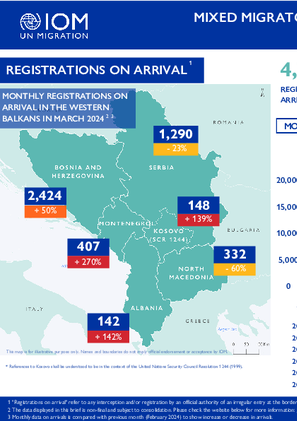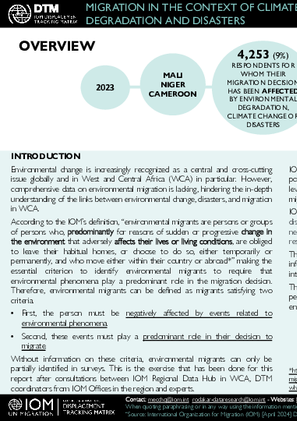-
Countries
-
Data and Analysis
-
Special Focus
-
Crisis Responses
Compilation/Overview
Color
white
Monthly Overview of:
- Arrivals in the Western Balkans
- Top three nationalities at arrivals in the reporting month
- Migrants presence in reception facilities
- Assisted Voluntary Returns and reintegration

Contact
DTM Iraq, IraqDTM@iom.int
Language
English
Location
Iraq
Period Covered
Mar 01 2016
Jun 30 2021
Activity
- Survey
- Community Perception
- Displacement Solutions
- Return Intention
- Mobility Tracking
- Baseline Assessment
What happens to households experiencing protracted displacement during a global pandemic? This is not a question that Access to Durable Solutions Among IDPs in Iraq, a panel study conducted by IOM and Georgetown University, initially anticipated answering at its inception six years ago.1 Yet this question is one the study is uniquely positioned to answer. The mixed-method project collects data from surveys and interviews to understand how the same Iraqi IDP households displaced by the conflict with the Islamic State in Iraq and the Levant (ISIL) try to access a “durable solution” to their displacement as defined by the Inter-Agency Standing Committee’s Framework on Durable Solutions. Conducted among the non-camp population of IDPs displaced between 2014 and 2015, the study operationalized the eight criteria that collectively measure a durable solution: safety and security, standard of living, livelihood, housing, access to documentation, family reunification, participation in public affairs, and access to justice. Using each of these criteria over six rounds of data collection, the study has tracked changes in what challenges IDP households face and the solutions they engineer as they search for a durable solution to their displacement. Based on findings from the newest, sixth round of data collection, this report details not only how COVID-19 affects IDPs, but specifically, and in keeping with the purpose of the study, how the COVID-19 pandemic affected IDP households’ abilities to achieve a durable solution. This latter endeavor entails two tasks: first, to identify what challenges persist because they existed pre-COVID-19 (and are thus primarily displacement-related), and second, to identify what challenges the COVID-19 pandemic has created or made worse. The longitudinal nature of the Access to Durable Solutions study and its ability to compare current findings with past trends using the same indicators facilitated disentangling and completing these two tasks
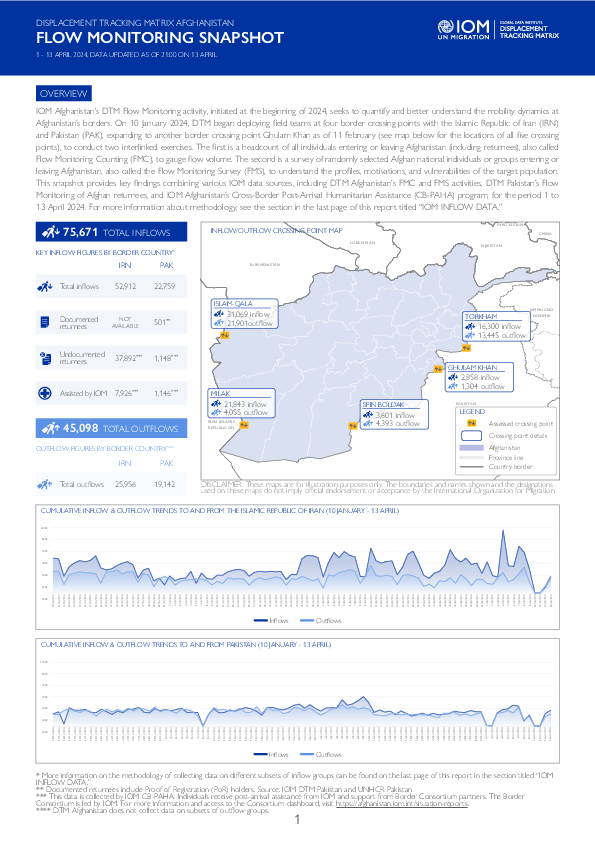
Contact
DTMAfghanistan@iom.int
Language
English
Location
Afghanistan
Period Covered
Apr 01 2024
Apr 13 2024
Activity
- Survey
- Flow Monitoring Survey
- Flow Monitoring
IOM Afghanistan's DTM Flow Monitoring activity, initiated at the beginning of 2024, seeks to quantify and better understand the mobility dynamics at Afghanistan’s borders. On 10 January 2024, DTM began deploying field teams at four border crossing points with the Islamic Republic of Iran (IRN) and Pakistan (PAK), expanding to another border crossing point Ghulam Khan as of 11 February (see map below for the locations of all five crossing points), to conduct two interlinked exercises. The first is a headcount of all individuals entering or leaving Afghanistan (including returnees), also called Flow Monitoring Counting (FMC), to gauge flow volume. The second is a survey of randomly selected Afghan national individuals or groups entering or leaving Afghanistan, also called the Flow Monitoring Survey (FMS), to understand the profiles, motivations, and vulnerabilities of the target population. This snapshot provides key findings combining various IOM data sources, including DTM Afghanistan’s FMC and FMS activities, DTM Pakistan’s Flow Monitoring of Afghan returnees, and IOM Afghanistan’s Cross-Border Post-Arrival Humanitarian Assistance (CB-PAHA) program, for the period 1 to 13 April 2024. For more information about methodology, see the section in the last page of this report titled “IOM INFLOW DATA.”
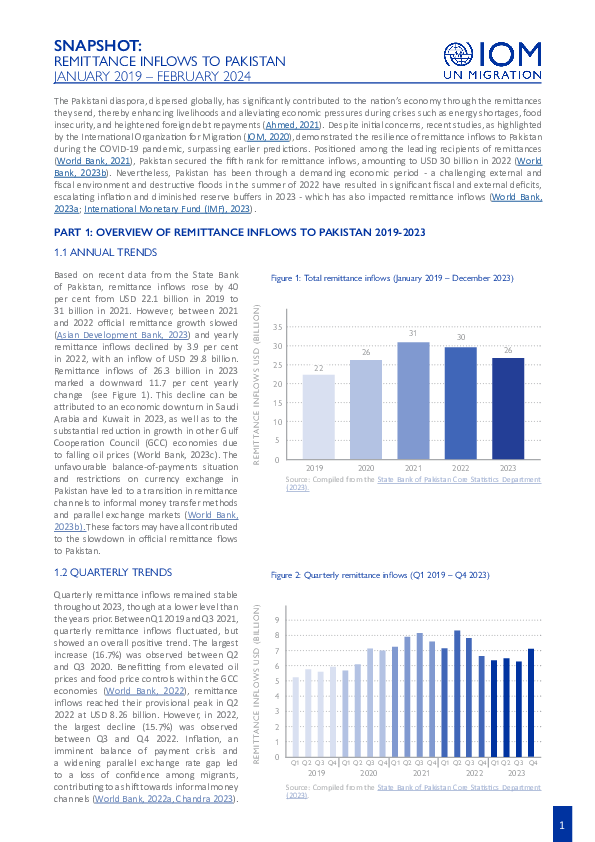
Contact
rdhroapsupport@iom.int, dtmremapsupport@iom.int
Language
English
Location
Pakistan
Period Covered
Jan 01 2019
Feb 29 2024
Activity
- Other
This report on remittance inflows to Pakistan from 2019 to 2024 details the fluctuating trends in money sent home by the Pakistani diaspora. The report highlights the economic impact of these financial transfers. Initially, remittances grew significantly, reaching USD 31 billion in 2021, but this was followed by a decline, with 2023 seeing a drop to USD 26.3 billion, largely due to economic issues in the Gulf Cooperation Council countries and restrictive financial policies in Pakistan. Despite these challenges, remittance inflows remained a critical source of foreign exchange and economic stability, particularly during crises such as the COVID-19 pandemic and the 2022 floods.
Environmental change is increasingly recognized as a central and cross-cutting issue globally and in West and Central Africa (WCA) in particular. However, comprehensive data on environmental migration is lacking, hindering the in-depth understanding of the links between environmental change, disasters, and migration in WCA.
According to the IOM’s definition, “environmental migrants are persons or groups of persons who, predominantly for reasons of sudden or progressive change in the environment that adversely affects their lives or living conditions, are obliged to leave their habitual homes, or choose to do so, either temporarily or permanently, and who move either within their country or abroad” making the essential criterion to identify environmental migrants to require that environmental phenomena play a predominant role in the migration decision.
This first dashboard aims at providing detailed information and evidence on people on the move in the context of disasters, climate change, and environmental degradation.
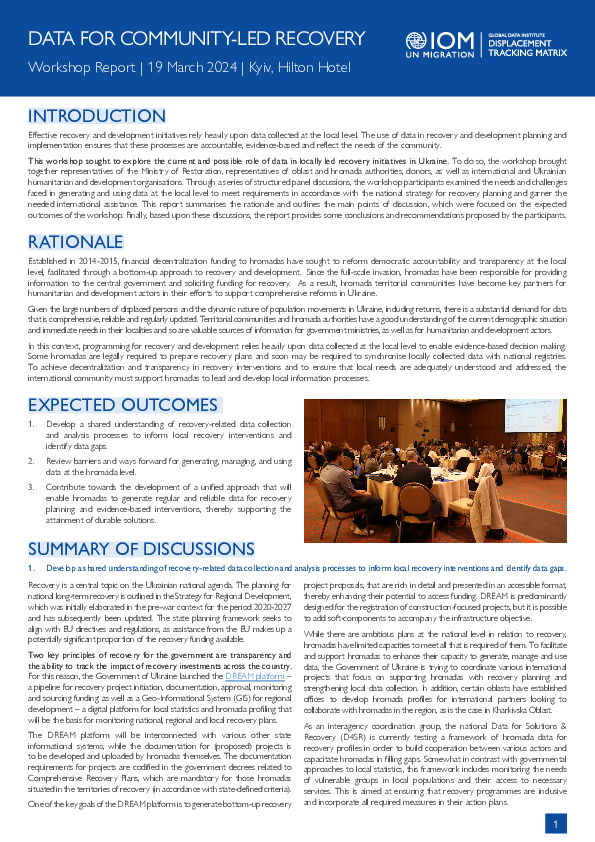
Contact
DTM Ukraine, dtmukraine@iom.int
Language
English
Location
Ukraine
Snapshot Date
Mar 19 2024
Activity
- Other
Effective recovery and development initiatives rely heavily upon data collected at the local level. The use of data in recovery and development planning and implementation ensures that these processes are accountable, evidence-based and reflect the needs of the community.
This workshop sought to explore the current and possible role of data in locally led recovery initiatives in Ukraine. To do so, the workshop brought together representatives of the Ministry of Restoration, representatives of oblast and hromada authorities, donors, as well as international and Ukrainian humanitarian and development organisations. Through a series of structured panel discussions, the workshop participants examined the needs and challenges faced in generating and using data at the local level to meet requirements in accordance with the national strategy for recovery planning and garner the needed international assistance.
This report summarises the rationale and outlines the main points of discussion, which were focused on the expected outcomes of the workshop. Finally, based upon these discussions, the report provides some conclusions and recommendations proposed by the participants.
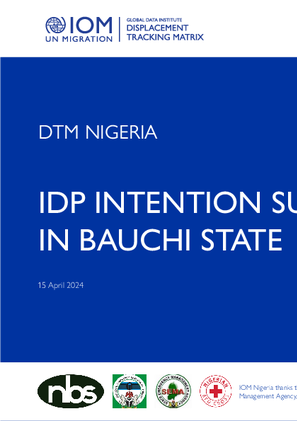
Contact
DTM Nigeria, iomnigeriadtm@iom.int
Language
English
Location
Nigeria
Period Covered
Nov 16 2023
Dec 18 2023
Activity
- Survey
- Displacement Solutions
- Return Intention
While many of the IDPs continued to be displaced for prolonged periods, there is a noticeable trend of increasing numbers of IDPs returning to their places of origin, as evidenced by Round 45 of DTM assessments (June 2023) identified 2,075,257 returnees in the region. Recognizing the growing number of returnees, the IOM Displacement Tracking Matrix (DTM), in collaboration with the Camp Coordination and Camp Management (CCCM)/Shelter and NFI and Protection sectors, including the National Emergency Management Agency (NEMA), National Bureau of Statistics (NBS), State Emergency Management Agency (SEMA), Nigeria Red Cross Society (NRCS), and other key partners deemed it necessary to assess the future intentions (within the next 12 months) of individuals in displacement areas to provide appropriate solution interventions. The DTM team, with the support of the partners, led the Intention Survey (IS) in Bauchi State (including the other five states of the north-east) to assess IDPs who wish to return to their place of origin, locally integrate at their current location of displacement or relocate to another part of the state (LGA), within or outside the country.
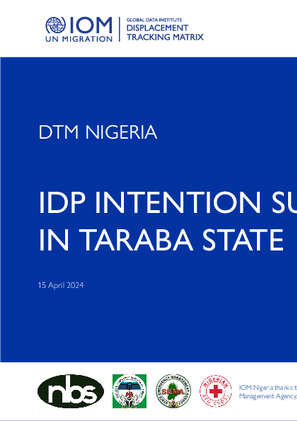
Contact
DTM Nigeria, iomnigeriadtm@iom.int
Language
English
Location
Nigeria
Period Covered
Nov 16 2023
Dec 18 2023
Activity
- Survey
- Displacement Solutions
- Return Intention
While many of the IDPs continued to be displaced for prolonged periods, there is a noticeable trend of increasing numbers of IDPs returning to their places of origin, as evidenced by Round 45 of DTM assessments (June 2023) identified 2,075,257 returnees in the region. Recognizing the growing number of returnees, the IOM Displacement Tracking Matrix (DTM), in collaboration with the Camp Coordination and Camp Management (CCCM)/Shelter and NFI and Protection sectors, including the National Emergency Management Agency (NEMA), National Bureau of Statistics (NBS), State Emergency Management Agency (SEMA), Nigeria Red Cross Society (NRCS), and other key partners deemed it necessary to assess the future intentions (within the next 12 months) of individuals in displacement areas to provide appropriate solution interventions. The DTM of the IOM Nigeria Mission, with the support of the partners, led the Intention Survey (IS) in Taraba State (including the other five states of the north-east) to assess IDPs who wish to return to their place of origin, locally integrate at their current location of displacement or relocate to another part of the state (LGA), within or outside the country.

Contact
DTM Nigeria, iomnigeriadtm@iom.int
Language
English
Location
Nigeria
Period Covered
Nov 16 2023
Dec 18 2023
Activity
- Survey
- Displacement Solutions
- Return Intention
While many of the IDPs continued to be displaced for prolonged periods, there is a noticeable trend of increasing numbers of IDPs returning to their places of origin, as evidenced by Round 45 of DTM assessments (June 2023) identified 2,075,257 returnees in the region. Recognizing the growing number of returnees, the IOM Displacement Tracking Matrix (DTM), in collaboration with the Camp Coordination and Camp Management (CCCM)/Shelter and NFI and Protection sectors, including the National Emergency Management Agency (NEMA), National Bureau of Statistics (NBS), State Emergency Management Agency (SEMA), Nigeria Red Cross Society (NRCS), and other key partners deemed it necessary to assess the future intentions (within the next 12 months) of individuals in displacement areas to provide appropriate solution interventions. The DTM of the IOM Nigeria Mission, with the support of the partners, led the Intention Survey (IS) in Gombe State (including the other five states of the north-east) to assess IDPs who wish to return to their place of origin, locally integrate at their current location of displacement or relocate to another part of the state (LGA), within or outside the country.
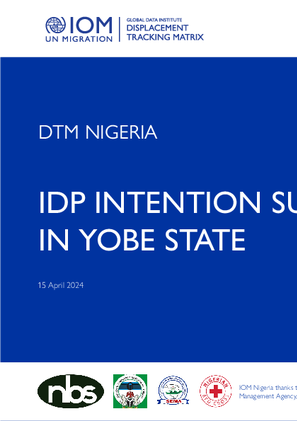
Contact
DTM Nigeria, iomnigeriadtm@iom.int
Language
English
Location
Nigeria
Period Covered
Nov 16 2023
Dec 18 2023
Activity
- Survey
- Displacement Solutions
- Return Intention
While many of the IDPs continued to be displaced for prolonged periods, there is a noticeable trend of increasing numbers of IDPs returning to their places of origin, as evidenced by Round 45 of DTM assessments (June 2023) identified 2,075,257 returnees in the region. Recognizing the growing number of returnees, the IOM Displacement Tracking Matrix (DTM), in collaboration with the Camp Coordination and Camp Management (CCCM)/Shelter and NFI and Protection sectors, including the National Emergency Management Agency (NEMA), National Bureau of Statistics (NBS), State Emergency Management Agency (SEMA), Nigeria Red Cross Society (NRCS), and other key partners deemed it necessary to assess the future intentions (within the next 12 months) of individuals in displacement areas to provide appropriate solution interventions. The DTM, with the support of the partners, led the Intention Survey (IS) in Yobe State (including the other five states of the north-east) to assess IDPs who wish to return to their place of origin, locally integrate at their current location of displacement or relocate to another part of the state (LGA), within or outside the country.
Pagination
- Previous page
- Page 9
- Next page
